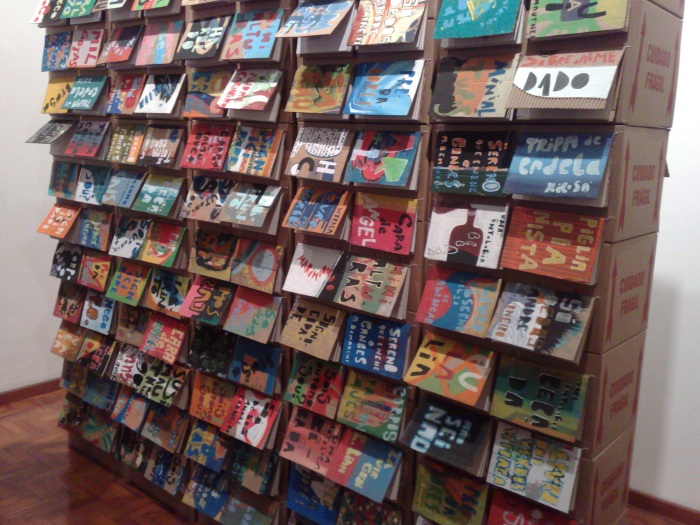Lucia Rosa, Dulcinea catadora Collective por Selene Wendt

When asked to suggest an artist to be featured in this issue of Interference Channel dedicated to education, I immediately chose Lúcia Rosa of the Dulcinéia Catadora collective of artists, writers and catadores. Having recently had the opportunity to work with Lúcia Rosa on a special book project for youth in the Morro do Palacio favela near The Niteroi Contemporary Art Museum in Brazil for the exhibition The Art of Storytelling, I witnessed first hand what makes Dulcinéia Catadora an ideal model for socially engaged collective art practice.
The Dulcinéia Catadora collective, based in São Paulo, Brazil, publishes poetry and short stories in the form of small cardboard books. These publications, which are hand painted and sewn one by one, are the central axis of their creative process, with sustainability and empowerment as core values of their practice. The artist Lúcia Rosa launched Dulcinéia Catadora in São Paulo in 2007 with Peterson Emboava (the then 19-year old son of a street collector/recycler) after both worked at the 27th São Paulo Biennial with Eloísa Cartonera, the Argentine artist/writers collective that started this practice in 2003. Having already published more than one hundred titles, Dulcinéia Catadora follows a visionary path that enables them to promote young and unpublished authors, thereby opening up for new narratives and opportunities within contemporary Latin American literature.

Dulcinéia Catadora is part of what has become both a local and transnational dialogue centered on a very specific form of collaborative art and literary practice also known as ‘cartonera publishing’ that has similar branches throughout Latin America. Dulcinéia Catadora’s work is consistently driven by clearly defined values and ideals. They provide a platform for artistic and literary expression for individuals whose voices would otherwise not be heard and for the underprivileged of society, and with each new project participants are directly compensated for their time and participation. In direct contact with The National Movement of Cardboard Pickers, they truly value the work of cardboard recyclers. The collective purchases cardboard boxes from the cardboard recyclers for a higher price than what the commercial outlets would pay. The cardboard is then cut and painted to create book covers. Each book is sold for ten reais and the income is shared among the participants.

What makes Dulcinéia Catadora so special is that they provide a unique opportunity to ‘distribute the sensible’ while also questioning power structures within society, and within art and literature. As such, Jacques Rancière’s theory of ‘The Distribution of the Sensible’ is fundamental to their overall philosophy. By working over an extended period of time, with art and literature as tools, they empower participants in their workshops through respect and active engagement. With each new project they implement art and literature to create societal change. I first heard about Dulcinéia Catadora in relation to their work with a youth group at Pedra Lisa, the poorest part of a favela called Providênciais, situated near the port of Rio de Janeiro.
My own experience with Lúcia Rosa enforced my positive impression of Dulcinéia Catadora as a visionary model for collective art practice. As an exhibition centered on the power of storytelling I was interested in finding ways to allow completely new stories and narratives to unfold. With particular emphasis on Brazilian artists, I sought to make the exhibition relevant and accessible to the local community. Each hand-painted cover of the catalogue/book, and the collaborative work featured in the exhibition, was created by youth who participated in workshops that took place over a period of several months before the exhibition. The book project became an opportunity to bridge the gap between the local community and The Niteroi Contemporary Art Museum situated right below the Morro do Palacio favela.

Youth who participated in the workshops were introduced to linguistic and artistic games that Lúcia Rosa designed to expose the youth to literature, poetry and art. These activities were directly inspired by encounters with additional artists and writers who were also invited into the workshops. Similar to projects that Dulcinéia Catadora has been involved in throughout Brazil and as far away as Mozambique, Lúcia Rosa actively engaged youth from the local community in the creative process and outcome of the exhibition catalogue/book for The Art of Storytelling. Lúcia Rosa also invited other artists and writers to participate in the book project and workshops, including Magne Furuholmen, Rosana Ricalde, Fabio Morais, Paulo Scott, Douglas Diegues and Sergio Sant´Anna. This further emphasized the dialogue between art and literature that was the source of inspiration for the exhibition, and provided an opportunity for the youth to meet a few of the artists featured in the exhibition, as well as some prominent authors whose work appears in the publication.
With each new encounter and with every blank piece of cardboard that was gradually transformed into a one-of-a-kind cover, trust was built and the sound of laughter filled the air. The final result is an exhibition catalogue/book that reflects the dreams, aspirations, stories and ideas of the participating youth. I cannot imagine a more perfect example of an approach to art and literature that, in additional to being educational, is truly innovative and inspirational. ♦